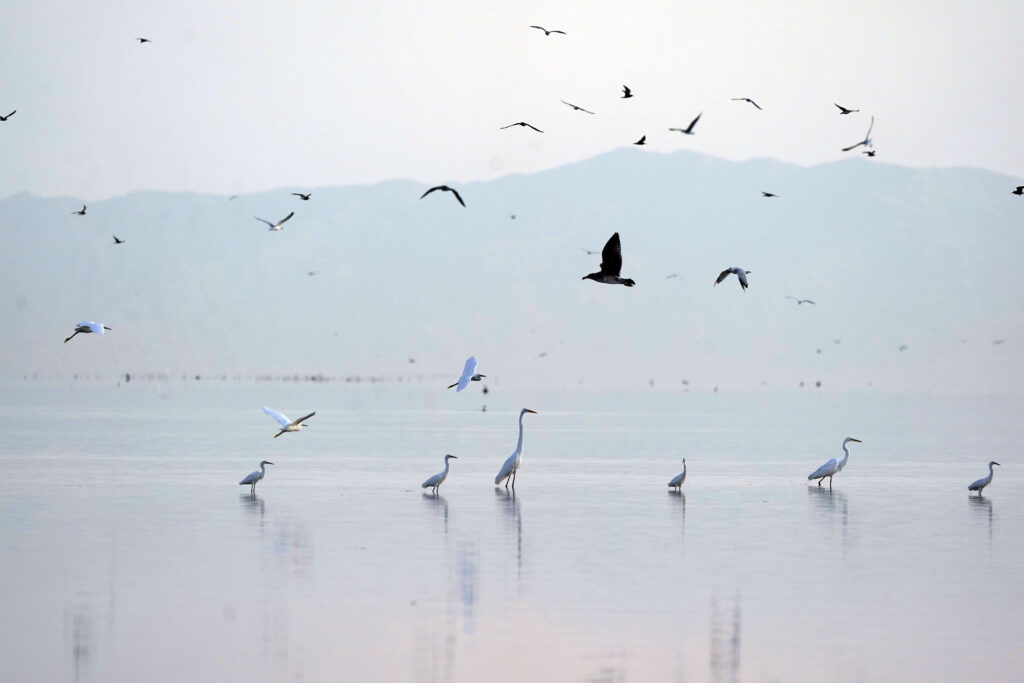Many of California’s reservoirs are significantly below their historic levels for this time of year, some even as low as they were back in 2014 when the drought emergency declaration was issued. The government will spend $250 million over 4 years to restore and clean up drying Southern California lake. The associated Press has the story:
Drying CA lake to get $250M in US drought funding
Newslooks- SACRAMENTO, Calif. (AP)
The federal government said Monday it will spend $250 million over four years on environmental cleanup and restoration work around a drying Southern California lake that’s fed by the depleted Colorado River.
The future of the Salton Sea, and who is financially responsible for it, has been a key issue in discussions over how to stave off a crisis in the Colorado River. The lake was formed in 1905 when the river overflowed, creating a resort destination that slowly morphed into an environmental disaster as water levels receded, exposing residents to harmful dust and reducing wildlife habitat.
The lake is largely fed by runoff from farms in California’s Imperial Valley, who use Colorado River water to grow many of the nation’s winter vegetables as well as feed crops like alfalfa. As the farmers reduce their water use, less flows into the lake. California said it would only reduce its reliance on the over-tapped river if the federal government put up money to mitigate the effects of less water flowing into the sea.
“It’s kind of a linchpin for the action we need to see on the Colorado River,” said Wade Crowfoot, California’s natural resources secretary. “Finally we are all in agreement that we can’t leave the Salton Sea on the cutting room floor, we can’t take these conservation actions — these extraordinary measures — at the expense of these residents.”
The deal announced Monday needs approval from the Imperial Irrigation District, the largest user of Colorado River water. The water entity’s board will take it up on Tuesday.
Both the district’s general manager and board member JB Hamby applauded the deal Monday.
“The collaboration happening at the Salton Sea between water agencies and state, federal, and tribal governments is a blueprint for effective cooperation that the Colorado River Basin sorely needs,” Hamby said in a statement.
The $250 million will come out of the recently passed Inflation Reduction Act, which set aside $4 billion to stave off the worst effects of drought across the U.S. West.
Most of the money is contingent on the Imperial Irrigation District and Coachella Valley Water District making good on their commitments to reduce their own use of river water. Both submitted proposals to cut back their usage for payment as part of a new federal program.
The quarter-billion dollars will largely go to bolster and speed up existing state projects designed to lower the negative environmental impact of the drying lake bed. The state has committed nearly $583 million to projects at the sea, including dust suppression and habitat restoration. One project underway aims to create wetlands and ponds that will limit dust from blowing into the air while creating safe spaces for fish and birds, according to the state.
The deal comes as the U.S. Interior Department and the seven states that rely on the river — California, Arizona, New Mexico, Colorado, Nevada, Utah and Wyoming — scramble to stave off the worst impacts of the ongoing drought and historic overuse of the river. Lakes Powell and Mead, the key reservoirs that store river water and provide hydropower across the West, are only about a quarter full.
After months of failed negotiations over a deal to drastically cut water use, the federal government in October said it would pay farmers and cities to cut back through activities like leaving fields unplanted or lining canals to prevent water from seeping into the ground. Proposals were due earlier this month. Meanwhile, the Interior Department has taken steps to unilaterally revise guidelines that govern when water shortages are declared, a move that could force states to further cut back.
The Salton Sea, meanwhile, became its own political flashpoint in October when Arizona Sen. Mark Kelly, then up for reelection, urged the federal government to withhold any environmental cleanup money unless California agreed to give up more water. That prompted criticism he was using communities who already suffer from poor air quality as a bargaining chip.
The agreement marks a good step forward but key details still need to be fleshed out, said Frank Ruiz, Salton Sea program director for Audubon California. He worries that $250 million is not enough to mitigate all of the damage already done at the sea.
“This is a great step but I think we need a lot more,” he said. “We need to continue discussing water sustainability in the region.”
Broadly, he wants to see a more equitable distribution of the region’s water supplies and hopes the Salton Sea gets a guaranteed minimum amount of water even as overall use declines.







